

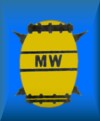
INTRODUCTION
Responsibility for Royal Navy minewarfare was first vested in the Gunnery Branch but this was divested to the Torpedo Branch on its formation in 1876. Henceforth, Torpedo officers and seaman (later to became members of the Torpedo & Anti-Submarine (TAS) Branch) conducted minesweeping and mine-laying operations in regular RN vessels until 1975. Their training was undertaken at the Mining and Anti-Mining Department of the Torpedo School at HMS Vernon in Portsmouth where mines and mine countermeasures were developed throughout both world wars. Paradoxically, the Gunnery Branch retained responsibility for naval diving until this, too, was divested to the Torpedo Branch on 1 October 1944.
FIRST STIRRINGS
In 1907 Admiral Lord
Charles Beresford was Commander-in-Chief of the Home Fleet. After a visit
to ports on the east coast of England, he was the first to recommend the use of
Grimsby trawlers for minesweeping duties. He wrote:
"Our fishing fleets, in war, will be rendered inactive and will, in consequence be available for war service. Fishermen, by virtue of their calling, are adept in the handling and towing of wires and trawls, more so than are naval ratings. Small naval vessels, if used in minesweeping, will be used at the expense of other urgent war requirements."
WORLD WAR I
Admiral Lord Beresford's prescience eventually led to the formation of the Royal Naval Reserve (Trawler Section) - the RNR(T). The Trawler Reserve was instituted with approval for 100 trawlers to be mobilised during any period of strained relations and for the immediate enrolment of 1,000 officers and ratings to man these vessels. This brought a new rank, that of 'Skipper' RNR, into the Navy List and the first officer (Peter Yorston) enrolled at Aberdeen on 3 February 1911. By the end of 1911, 53 skippers had joined. In 1912 a further 25 enrolled and the Trawler Section of the Royal Naval Reserve consisted of 142 trawlers manned by 1,279 personnel. 31 more skippers joined before the war started in August 1914 making a total of 109. 315 more volunteered by the end of the first week in October. By the end of 1915 the Minesweeping Service employed 7,888 officers and men.
Within the first week of war, 94 trawlers were allocated for minesweeping duties and dispersed to priority areas including Cromarty, the Firth of Forth, the Tyne. the Humber, Harwich, Sheerness, Dover, Portsmouth, Portland and Plymouth. The groups were commanded by naval officers, some from the retired list, who had received a brief training in minesweeping. Apart from the skippers, officers were also required to supplement the handful of naval officers of the existing minesweeping service. Most of the trained pre-war RNR and RNVR officers had already been called up for service in the Fleet. For the new minesweeping and auxiliary patrol flotillas, officers and civilians were obtained from the Merchant Navy and given temporary commissions in the RNR and RNVR. To bolster naval discipline, various Royal Fleet Reserve and pensioner petty officers were distributed among the vessels.
When the Armistice was signed at the end of WW I, the Trawler Reserve consisted of 39,000 officers and men of whom 10,000 were employed in minesweepers and the rest in the auxiliary patrol. The 10 ex-torpedo gunboats available as minesweepers at the outbreak of the war had been replaced by purpose-built ships including 72 Flower Class single-screw fleet minesweeping sloops of the Acacia, Arabis and Azalea types, 107 Hunt Class and Improved Hunt (Aberdare) Class twin-screwed minesweepers, 24 'Class of 24' fleet sweeping sloops, 32 Ascot Class and Improved Ascot Class minesweeping paddle-steamers, 13 Grimsby Class general purpose sloops and 10 Dance Class 'Tunnel Tug' inshore minesweepers. Total RN minesweeping forces included 762 ships stationed at 26 home ports and 35 foreign bases. 214 minesweepers had been lost during the four years and three months of the war.
BETWEEN THE WARS
At the end of the Great War, the Admiralty appointed an International Mine Clearance Committee on which 26 countries were represented. The Supreme War Council allotted each Power an area to clear, the largest falling to Great Britain. Some 40,000 square miles of sea needed clearing. In February 1919 a Mine Clearance Service was formed with special rates of pay and conditions of service. Members of the Service wore a specific metal cuff badge and cap tally. By the end of 1919 over 23,000 Allied and 70 German mines had been swept with the loss of half a dozen minesweepers.

RN Mine Clearance Service Badge
The plaque shown below is inscribed 'HMS Mallow 1918 - 1920'. A metal Mine Clearance Service badge forms the centre-piece and this is surrounded by smaller metal shields detailing 'Minefields Swept' including: Wellington, New Zealand; Aukland, New Zealand; Eden, Australia; and Anamba, Singapore. HMS Mallow was a British Flower Class sloop (Minesweeping) transferred to Australia at the end of WW I. The minefields are assumed to have been laid by the German raider Wolf.
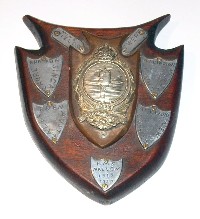
HMS Mallow Commemorative Plaque
On completion of the post-war clearance operations, the Minesweeping Division of the Admiralty was disbanded. Later, one flotilla of Fleet minesweepers was allocated for training and this was joined by 3 trawlers from the RNR. This unit was named the Royal Naval Patrol Service (RNPS) and fortnightly courses were run at Portsmouth.
WORLD WAR II
World War II found the Torpedo Branch still responsible for Minesweeping and Mining operations in regular ships of the Royal Navy. Regular RN minesweeping forces comprised about 40 Fleet minesweepers, half of which were ex-WW I coal-burning Improved Hunt (Aberdare) Class fleet minesweeping sloops (Smokey Joes) mostly laid up at Malta and Singapore. By D-Day, there were over 1,200 minesweepers of various types in RN operation including Algerine, Halcyon and Bangor Class Fleet minesweepers, British American Minesweepers (BAMS), Motor Minesweepers (MMS or 'Mickey Mouse'), British Yard Minesweepers (BYMS) as well as numerous converted trawlers and drifters. 50,000 RN personnel were involved in operational Mine Countermeasures.
When the Royal Naval Reserves were mobilised in August 1939, the Sparrow's Nest at Lowestoft became the Central Depot of the RNPS (Royal Naval Patrol Service). Located at the most easterly point of Great Britain, this was the closest military establishment to the enemy. The advantages of using small ships for minesweeping and other duties had been recognised during WW1 and many of the crews of the peacetime fishing fleets had been encouraged to join the Royal Naval Reserve.
First known as 'Pembroke X', the depot later became HMS Europa and was the administrative headquarters for more than 70,000 men and 6,000 ships including trawlers, drifters, MFVs (Motor Fishing Vessels), MLs (Motor Launches), and later MMS (Motor Minesweepers or 'Mickey Mouses'), American produced BYMS and numerous requisitioned vessels. Within a short while the Royal Navy had almost taken over Lowestoft with the establishment of no fewer than five Naval Bases: HMS Europa (RNPS Headquarters), HMS Martello (the local Minesweeping Base), HMS Mantis (Coastal Forces MGB's and MTB's), HMS Minos (Harbour Defence, small escort and other craft) and HMS Myloden (Landing Craft Training for RM Commandos and Combined Operations).
The RNPS fought all over the world in all theatres of the war and was mainly involved with minesweeping and anti-submarine work. The only RNPS VC was won at Namsos during the Narvik campaign but over 850 other awards were made to RNPS personnel as well as over 200 Mention in Despatches. RNPS vessels were on convoy duty in the Atlantic and the Arctic, in the Mediterranean and the Far East but many will first think of them keeping the War Channel clear. Throughout the early years of the war, the Germans laid mines by sea and air around the British Isles in an attempt to strangle the coastal convoys that kept Britain supplied. The RNPS worked hard to keep the shipping lane clear so that the convoys could continue. This meant constant minesweeping because, each time an area was cleared, E-boats or aircraft mined it again.
This hazardous work was recognised by the award of a unique silver badge to RNPS minesweeping and anti-submarine crews. It was not an automatic award and was only given to those officers and ratings who had completed six months sea-time. The first issue had a vertical pin at the back but so many of these were lost that it was changed to having four small eyes so that it could be sewn onto the sleeve.
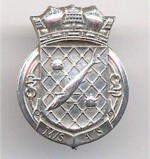
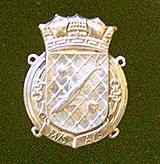
Royal Naval Patrol Service Badges
Because the majority of RNPS personnel were Royal Naval Reservists, it became a 'Navy within a Navy' and was given a number of unofficial titles; 'Harry Tate's Navy' and 'Churchill's Pirates' being two of the more mentionable. The peacetime crews becoming Naval seamen together made for a special camaraderie which continued in the Service throughout WW II. By the end of the war, most RNPS members were 'hostilities only' who had probably had no connection with the sea before.
306 Allied minesweepers participated in the initial D-Day assault on 6 June 1944. These included 274 from the Royal Navy, 84 of which had been built in America under Lend-Lease. 32 minesweepers flew the US Navy ensign and 15 of the Bangor Class fleet minesweepers were built in Canada and manned by Canadians. The Canadian 31st MS Flotilla (Bangors) swept 78 mines in the first 7 days of the operation. 36 converted RN Fairmile ‘B’ MLs (Motor Launches) were also used to conduct skim sweeps ahead of fleet Minesweeper Flotillas and many converted landing craft undertook snag-line sweeps in the shallows.
British minesweeping forces assigned to Operation Neptune for the Normandy invasion included:
25 x Algerine Class fleet minesweepers
29 x Bangor Class fleet minesweepers
12 x Catherine Class BAMS (British American Minesweepers) fleet minesweepers
9 x Halcyon Class fleet minesweepers
9 x Aberdare Class ('Smokey Joes' - improved Hunt Class dating from WW I) fleet minesweepers
40 x BYMS (British Yard Minesweepers) coastal minesweepers
61 x MMS (Motor Minesweepers or ‘Mickey Mouse’) coastal minesweepers
38 x danlaying trawlers
36 x Fairmile ‘B’ MLs for inshore work.
It is worth noting that this comprised only 25% of the RN’s minesweeping forces at the time; the rest were still involved in keeping UK coastal routes and port approaches clear or were operating in other theatres of the war.
Two ships in each fleet Minesweeper Flotilla were fitted with radio countermeasures to confuse the German fire control radar as were a number of BYMS and MMS. Escorting coastal craft and aircraft produced smoke screens to mask sweeping operations.
The danlaying force in the British sector included 8 converted fleet minesweepers built during the war and 25 pre-war trawlers each carrying 70 danbuoys. The coastal minesweepers (BYMS, American YMS and MMS) performed their own danlaying. Taut Wire Measuring Gear assisted the accurate measurement of distances along channels and ten underwater sonic beacons were laid, using radio navigation, to provide accurate reference points for the start of each main channel. HMS Vernon produced 1,500 lights for danbuoys to mark the edges of channels plus 200 flashing lights for the ends of channels. On the night, they all worked well and gave a ‘fairyland look’ to the whole area of sea between the Isle of Wight and the beaches.
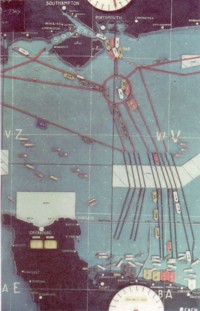
Southwick House D-Day Map
Some days before D-Day, a large circle of water (Piccadilly Circus) was swept a few miles south-east of the Isle of Wight connected to the existing swept channels off Southern England. On the night before the invasion, ten channels were cut south towards the Normandy coast. On the morning of the assault, channels and boat lanes were then swept into the beaches. These operations were broken down into 100 different serials, complicated by bad weather and severe cross-tides. The original intention had been for the fleet sweepers to wire-sweep and the coastal sweepers to influence-sweep but soon the fleet sweepers were also influence-sweeping and the BYMS, US YMS and some of the MMS were wire-sweeping on a wide scale too.
Despite coming under coastal battery fire and attack by E-boats, minesweeping casualties were relatively light to begin with. On 5 June, the sweeper USS Osprey was sunk in a moored minefield south of the Isle of Wight with the loss of six personnel and the fleet sweeper USS Tide was mined on 7 June with the loss of 21 personnel.

Mining of USS Tide 7 June 1944
Among other ships, however, mines claimed the destroyer USS Corry off Utah Beach three minutes before the assault hit the beaches and the American PC 1261 and 16 landing craft were lost later that day. On 7 June, the fleet destroyer HMS Swift was mined together with three more landing craft. On 8 June, the destroyers USS Glennon and USS Meredith, the destroyer escort USS Rich, the British netlayer Minster, the US LST 499 and several landing craft were all sunk in the same minefield while the destroyer USS Harding was heavily damaged.
Perhaps the greatest blow to British minesweeping forces occurred when three Catherine Class BAMS were lost off Normandy over a three day period a month after D-Day. On 6 July, HMS Cato and HMS Magic were sunk by Neger human torpedoes and on 8 July, HMS Pylades was sunk by a Neger. Some sources state Biber midget submarines were among the perpetrators but according to Biber operator Enrico Doering, these did not start operations off Normandy until August 1944.
POST WORLD WAR II
CIVILIAN ORGANISATIONS
In January 1953, the RN Minewatching Service (RNMWS) was formed. This was a civilian-manned organisation administered by the Admiralty and responsible in time of war for manning posts ashore and afloat around the coast of the UK and overlooking the principal navigable waterways. Its object was to spot mines dropped by enemy aircraft and report positions to local naval headquarters so that shipping could be warned and diverted as necessary and steps taken to deal with the mines. It was open to men and women of 26 and over and a free uniform was provided. The service's badge was a mine splash on the sea.
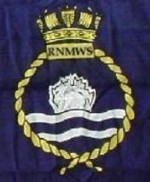
RN Minewatching Service Badge
In 1962 the Royal Naval Auxiliary Service (RNXS) was formed from the Royal Naval Minewatching Service in response to the nuclear threat to United Kingdom ports. It had the same badge as the RNMWS but with the substitution of the letters RNXS. Auxiliary-men were to be readily available to assist in the tasks of evacuating major ports and dispatching larger and faster merchant vessels overseas. The remaining ships, together with important port plant, were to be dispersed to safe anchorages along the coasts or in the islands. The sailing of merchantmen overseas involved setting up assembly anchorages where ships might be formed into convoys, a naval escort or surveillance arranged and information provided on routing, intelligence and communications. Auxiliarymen were required at Assembly anchorages' control points. These tasks were not new ones, indeed they had been performed by naval and merchant naval personnel throughout the past centuries. The nuclear threat, however, had cut the time available for transition from peace to war dramatically and the necessary organisation had to be developed or adapted to cope. Hence the formation of the RNXS.
In 1994 the RNXS was disbanded but was quickly resurrected in the form of the Maritime Volunteer Service (MVS), a charitable organisation. The MVS maintains a nucleus of uniformed volunteers trained to assist in routine surveillance as well as maritime emergencies both ashore and afloat at the many Units based around the UK coast. Uniformed membership is open to all those between the ages of 18 and 65 with a supporters' list open to all ages. Members come from all walks of life and include former members of the Royal Navy and its auxiliaries.

Maritime Volunteer Service Badge
ROYAL NAVY
On 10 October 1946, the Torpedo Branch divested its Electrical responsibilities to the recently formed Electrical Branch and merged with the Anti-Submarine Branch (formerly based at HMS Osprey at Portland) to form a new Torpedo and Anti-Submarine (TAS) Branch based at HMS Vernon. Hence, the TAS Branch assumed responsibility for naval minewarfare operations. TAS Branch officers and ratings undertook special courses to perform minewarfare operations including mining, minesweeping and minehunting.
In 1950 a sub-specialist scheme was approved for Seaman Branch TAS ratings. Second and third class TAS rates were divided into Control Ratings (UC), Weapons Ratings (UW) and Minesweeping, Minelaying and Seaward Defence Ratings (MD). In 1952 this sub-specialisation was extended to first class rate and qualifiers became TAS Instructors (TASIs) who were expected to know all about everything. Just before this last move it was decided that all TAS ratings should be trained in mine countermeasures and seaward defence so the MD sub-specialist rates were abolished.
On 25 February 1966 the combined Minewarfare & Clearance Diving Sub-Branch of the Seaman Branch was formed. Those officers who were previously qualified as both CD and TAS automatically became MCD officers while those qualified CD only were trained in Minewarfare. The cartoon below depicts the handover of minewarfare by the TAS Branch to the newly formed Minewarfare & Clearance Diving Branch with the blessing of the Director Undersea Warfare. From the 1980s a few officers were trained solely as Minewarfare specialists. MCD and MW officers appointed to certain posts also undertook the Advanced Minewarfare (AMW) course. The MCD rating structure remained unchanged until the formation of the Operations Branch.
TAS Branch Handover of Responsibility for Minewarfare to the
newly formed Minewarfare & Clearance Diving Sub-Branch
On 1 Jan 1975, the Mine Warfare (MW) Sub-Branch was formed as part of the new Operations Branch. TAS ratings were given the option of transferring to the new MW Sub-Branch or remaining as specialists in the Sonar Sub-Branch. In 1981, the MW Sub-Branch assumed responsibility for demolitions, formerly a responsibility of the Sonar (formerly TAS) Sub-Branch. New entrants are now trained as Mine Warfare specialist ratings able to operate minesweeping equipment, minehunting sonar systems and remotely operated vehicles (ROVs). Stream-training is provided based on whichever type of ship and system he or she will be joining. Use these links to download see information from the Royal Navy website about becoming a Warfare Officer (including Mine Warfare Officer) or a Mine Warfare Specialist Rating.
Back to History of RN Minewarfare & Clearance Diving